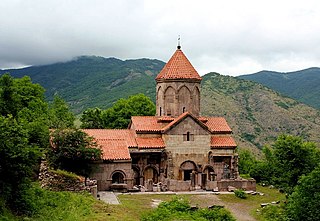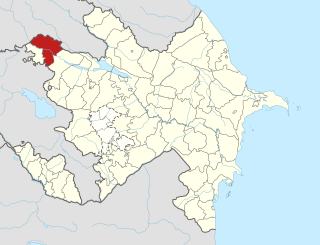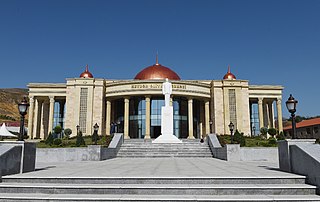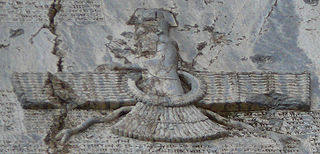
Syunik is the southernmost province of Armenia. It is bordered by the Vayots Dzor Province to the north, Azerbaijan's Nakhchivan Autonomous Republic exclave to the west, Azerbaijan to the east, and Iran to the south. Its capital and largest city is the town of Kapan. The Statistical Committee of Armenia reported its population was 141,771 in the 2011 census, down from 152,684 at the 2001 census.

Mingachevir is the fourth largest city in Azerbaijan with a population of about 106,000. It is often called the "city of lights" because of its hydroelectric power station on the Kur River, which divides the city down the middle.

The zurna is a double reed wind instrument played in the Central Asia, West Asia, the Caucasus, Southeast Europe and parts of North Africa. It is also used in Sri Lanka. It is usually accompanied by a davul in Armenian, Anatolian and Assyrian folk music.

Aghstafa District is one of the 69 districts of Azerbaijan. Located in the northwest of the country, it belongs to the Gazakh-Tovuz Economic Region. The district borders the districts of Qazakh, Tovuz, as well as the Kakheti and Kvemo Kartli regions of Georgia. Its capital and largest city is Aghstafa. As of 2020, the district had a population of 88,500.

Agsu District is one of the 69 districts of Azerbaijan. It is located in the east of the country, in the Mountainous Shirvan Economic Region. The district borders the districts of Ismayilli, Shamakhi, Kurdamir, and Hajigabul. Its capital and largest city is Agsu. As of 2020, the district had a population of 81,000.

Qakh District is one of the 69 districts of Azerbaijan. It is located in the north of the country, in the Shaki-Zagatala Economic Region. The district borders the districts of Zagatala, Shaki, Samukh, Yevlakh, as well as the Kakheti region of Georgia and the Russian Republic of Dagestan. Its capital and largest city is Qakh. As of 2020, the district had a population of 57,200.

Khachmaz District is one of the 69 districts of Azerbaijan. It is located in the northeast of the country and belongs to the Guba-Khachmaz Economic Region. The district borders the districts of Qusar, Quba, Shabran, and the Russian Republic of Dagestan. Its capital and largest city is Khachmaz. As of 2020, the district had a population of 179,800.

Gadabay is a city and the administrative center of the Gadabay District of Azerbaijan. It is located 444 km away from Baku, the capital of Azerbaijan.
Julfa, formerly Jugha, is a city and the capital of the Julfa District of the Nakhchivan Autonomous Republic of Azerbaijan.

Greater Iran or Greater Persia, also called the Iranosphere or the Persosphere, is an expression that denotes a wide socio-cultural region comprising parts of West Asia, the Caucasus, Central Asia, South Asia, and East Asia —all of which have been impacted, to some degree, by the Iranian peoples and the Iranian languages. It is defined by having been long-ruled by the dynasties of various Iranian empires, under whom the local populaces gradually incorporated some degree of Iranian influence into their cultural and/or linguistic traditions; or alternatively as where a considerable number of Iranians settled to still maintain communities who patronize their respective cultures, geographically corresponding to the areas surrounding the Iranian plateau. It is referred to as the "Iranian Cultural Continent" by Encyclopædia Iranica.

Zoroastrianism in Azerbaijan goes back to the first millennium BC or earlier and was the predominant religion of Greater Iran before the conversion to Islam.
The population of Armenia includes various significant minority ethnic groups.

Sotk is a village in the Vardenis Municipality of the Gegharkunik Province of Armenia, well known for its gold mines.
Alpout was a village in the current territory of Agsu Rayon of Azerbaijan. Nowadays, it is in the territory of the Bijo village in the same region.

Maştağa is a settlement and municipality in Baku, Azerbaijan. It has a population of 42,196. According to the popular historical manuscripts, the inhabitants of the village are the descendants of an ancient nomadic Turkish tribe which defeated and brought down Cyrus the Great and settled down in Baku during the 5th-6th centuries.
Rahimli is ancient Turkish village and municipality in the Goranboy District of Azerbaijan. It has a population of 1,109 (2009).

Quba is a city and the administrative centre of the Quba District of Azerbaijan. The city lies on the north-eastern slopes of Shahdag mountain, at an altitude of 600 metres above sea level, on the right bank of the Kudyal river. It has a population of 47,200 (2023).
Cəhri is a village and municipality in the Babek District of Nakhchivan, Azerbaijan. It is located 23 km in the north from the district center, on the bank of the Jahrichay River, on the foothill area. Its population is busy with grain growing, vegetable-growing and animal husbandry. There are two secondary schools, two kindergartens, five libraries, three mosques, a children's music school, a club and a hospital in the village. It has a population of 8,454. The settlement of the İşıqlar of the Middle Ages has been recorded in north-east of the village of Jahri.
Tivi is a village and municipality in the Ordubad District of Nakhchivan, Azerbaijan. It is located in near the Ordubad-Bist highway, 60 km north-east of the district center.

Azerbaijani carpet is a traditional carpet (rug) made in Azerbaijan. The Azerbaijani carpet is a handmade textile of various sizes, with a dense texture and a pile or pile-less surface, whose patterns are characteristic of Azerbaijan's many carpet-making regions. Traditionally, the carpets were used in Azerbaijan to cover floors, decorate interior walls, sofas, chairs, beds and tables.
















